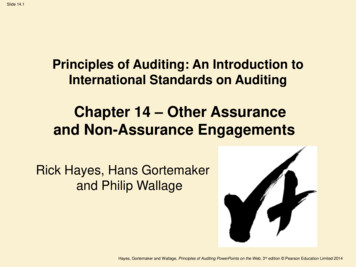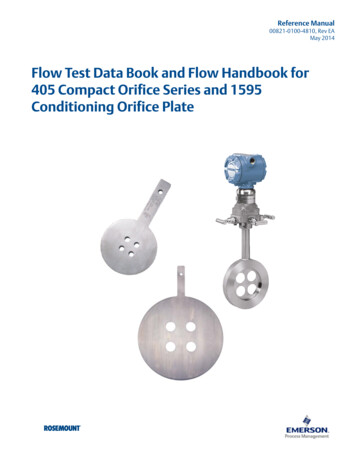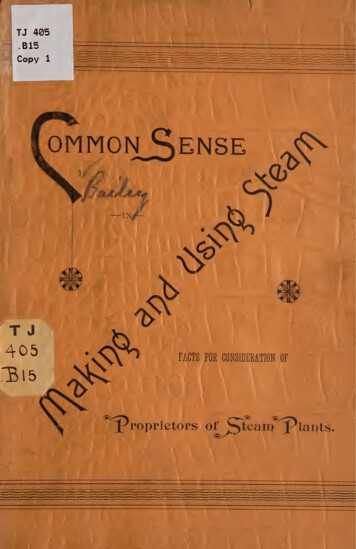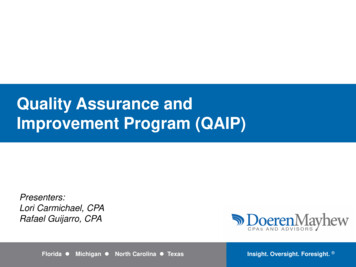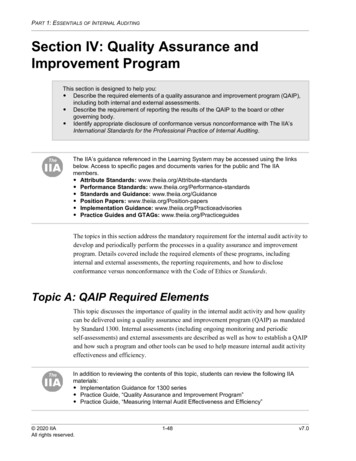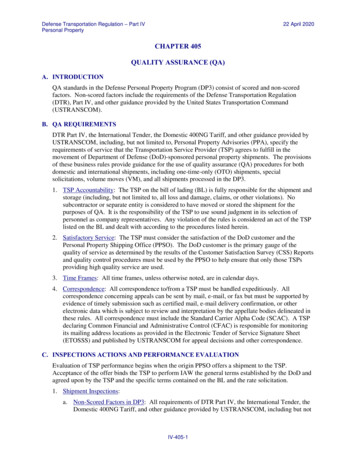
Transcription
Defense Transportation Regulation – Part IVPersonal Property22 April 2020CHAPTER 405QUALITY ASSURANCE (QA)A. INTRODUCTIONQA standards in the Defense Personal Property Program (DP3) consist of scored and non-scoredfactors. Non-scored factors include the requirements of the Defense Transportation Regulation(DTR), Part IV, and other guidance provided by the United States Transportation Command(USTRANSCOM).B. QA REQUIREMENTSDTR Part IV, the International Tender, the Domestic 400NG Tariff, and other guidance provided byUSTRANSCOM, including, but not limited to, Personal Property Advisories (PPA), specify therequirements of service that the Transportation Service Provider (TSP) agrees to fulfill in themovement of Department of Defense (DoD)-sponsored personal property shipments. The provisionsof these business rules provide guidance for the use of quality assurance (QA) procedures for bothdomestic and international shipments, including one-time-only (OTO) shipments, specialsolicitations, volume moves (VM), and all shipments processed in the DP3.1. TSP Accountability: The TSP on the bill of lading (BL) is fully responsible for the shipment andstorage (including, but not limited to, all loss and damage, claims, or other violations). Nosubcontractor or separate entity is considered to have moved or stored the shipment for thepurposes of QA. It is the responsibility of the TSP to use sound judgment in its selection ofpersonnel as company representatives. Any violation of the rules is considered an act of the TSPlisted on the BL and dealt with according to the procedures listed herein.2. Satisfactory Service: The TSP must consider the satisfaction of the DoD customer and thePersonal Property Shipping Office (PPSO). The DoD customer is the primary gauge of thequality of service as determined by the results of the Customer Satisfaction Survey (CSS) Reportsand quality control procedures must be used by the PPSO to help ensure that only those TSPsproviding high quality service are used.3. Time Frames: All time frames, unless otherwise noted, are in calendar days.4. Correspondence: All correspondence to/from a TSP must be handled expeditiously. Allcorrespondence concerning appeals can be sent by mail, e-mail, or fax but must be supported byevidence of timely submission such as certified mail, e-mail delivery confirmation, or otherelectronic data which is subject to review and interpretation by the appellate bodies delineated inthese rules. All correspondence must include the Standard Carrier Alpha Code (SCAC). A TSPdeclaring Common Financial and Administrative Control (CFAC) is responsible for monitoringits mailing address locations as provided in the Electronic Tender of Service Signature Sheet(ETOSSS) and published by USTRANSCOM for appeal decisions and other correspondence.C. INSPECTIONS ACTIONS AND PERFORMANCE EVALUATIONEvaluation of TSP performance begins when the origin PPSO offers a shipment to the TSP.Acceptance of the offer binds the TSP to perform IAW the general terms established by the DoD andagreed upon by the TSP and the specific terms contained on the BL and the rate solicitation.1. Shipment Inspections:a. Non-Scored Factors in DP3: All requirements of DTR Part IV, the International Tender, theDomestic 400NG Tariff, and other guidance provided by USTRANSCOM, including but notIV-405-1
Defense Transportation Regulation – Part IVPersonal Property22 April 2020limited to PPAs, is evaluated independently from Best Value Score (BVS) factors. Themonitoring of services via inspections is a critical component of this program and necessaryto ensure that DoD customers continue to receive the quality service promised by thisprogram and provided by industry. Punitive action for violations can be taken by the PPSOand/or USTRANSCOM.b. Inspection Standard: An inspection standard of not less than 50 percent (with an overall goalof 100 percent) of all inbound and outbound Personal Property shipments must be set byindividual Service policy. For occasions when physical inspections are not feasible,inspections can be telephonic and/or virtual; however telephonic/virtual inspections will notcount toward meeting the 50 percent standard. Mechanisms for quarterly reporting ofinspection rate and method of inspection will be established by individual Service policy.c. Inspection requests: When requested by another PPSO, the DoD customer, USTRANSCOM,or the TSP, a PPSO must make a maximum effort to inspect a specific shipment. This issubject to the PPSO's ability and Service policy. The following considerations must be madewhen requesting an inspection:(1) Whether or not an inspection was conducted at the origin(2) An indication of poor quality service or Tender of Service (TOS) violations on theshipment (which must be identified in the request for inspection)(3) Indications of the DoD customer’s dissatisfaction with the service provided by the TSPd. Shipment Evaluation and Inspection Record (DD Form 1780) Procedures:(1) The DD Form 1780, Figure 405-2, is a web form in Defense Personal Property System(DPS) and must be used by inspectors to record any TOS violations found on inbound oroutbound shipments.(2) Shipments not moving via DPS require a DD1780 to be completed manually.2. TSP Performance File: A performance file must be kept for TSPs. The files may be maintainedin DPS, electronically, and/or hard copy. PPSOs should utilize DPS capabilities to the fullestextent possible, minimizing hard copies. The TSP performance file should contain, or makereference to, the following (as applicable):a. Origin and destination shipment inspections (e.g., DD Form 1780)b. CSSc. Investigation records of complaints made against the TSPd. Shipment reweigh recordse. Letter of Warning (LOW) and Letters of Suspension (LOS) (DD Form 1814, on of Warning, Figure 405-1)f.TSP’s responses/corrective actions to LOW/LOS or complaintsg. All other communications concerning TSP’s performanceh. Photographs depicting substandard serviceNOTE: Items a, b, d, and e above are maintained in DPS and are available for review by thePPSO, USTRANSCOM, and Service HQs.Performance File Maintenance: Files must be maintained for both the international anddomestic shipments. TSP performance files must contain shipment information for 2calendar years.IV-405-2
Defense Transportation Regulation – Part IVPersonal Property22 April 20203. PPSO Review: When taking punitive action the PPSO will review the TSP’s overall performancewithin DPS for both failures and successes. The PPSO must look for recurring deficiencies orpatterns of unacceptable performance and initiate action to warn, suspend, or recommenddisqualification/non-use through USTRANSCOM.4. TSP Review: TSPs may review their performance within DPS. These reports include CSS,claims scores, LOW/LOS, among other performance factors. The PPSO will allow the TSP toreview their applicable performance file information that is not contained within DPS.D. PUNITIVE ACTIONSQA Actions: When a TSP violates any provision of its agreement and/or the DP3 business rules, thePPSO may issue a LOW, LOS, or recommend an action to USTRANSCOM. CSS comments may beused as supporting evidence in the issuance of a LOW/LOS. The PPSO must take into considerationthe severity of the violation, impact on the DoD customer, the quality of the TSP’s past performance,and the actions the TSP may have taken to correct the deficiencies. QA actions in the DP3 aresummarized below:1. LOW:A LOW serves as notice to a TSP that if violations or performance problems continue, suspensionaction may follow. LOWs must be prepared by the PPSO using DPS. A LOW is generated byDPS after an inspector inputs the violation in DPS. Violations are tallied by the system at aBLOC for a rolling 180 days for TSP inbound/outbound traffic. When a TSP commits the sameviolation three or more times during a 180-day period, suspension action may be considered.NOTE: A LOW may be issued for any violation(s) and is not limited to those listed on the DDForm 1780 (e.g., A LOW will be issued for failure to acknowledge receipt of a claim within 15calendar days or to pay, deny, or otherwise settle the claim within 60 calendar days [or 30calendar days if the claim is under 1,000]; e.g., A LOW will be issued within 60 calendar days ofmissing the RDD or agreed-upon delivery date from storage-in-transit [SIT] for failure to meet theRDD or to deliver on the agreed-upon delivery date from the SIT location due to the fault ornegligence of the TSP).A LOW, DD Form 1814, Figure 405-1, is issued by the PPSO to a TSP for unacceptableperformance. The LOW must state, as a minimum:a. DoD customer’s name,b. BL number, andc. The rule or regulation indicating the violation that resulted in the LOW.The TSP may view the DD Form 1780, which supports the warning in DPS. Notification of theLOW is sent to the TSP via DPS. Unless a written response is requested by the PPSO, TSPs arenot required to respond to LOWs.2. LOS:a. LOS: All LOS are overt actions by the PPSO to ensure the suspension action is appropriateand not due to system error. When a LOS is issued, DPS notifies the TSP of the suspensionaction. The LOS must state the following to substantiate the suspension:(1) DoD customer’s name,(2) BL number,(3) Rule or regulation violated on the shipment(s) (e.g., in accordance with [IAW] DTR PartIV, Appendix B).IV-405-3
Defense Transportation Regulation – Part IVPersonal Property22 April 2020(4) The PPSO must enter “Failure to provide corrective action within 30 days from theeffective date of a suspension may result in the LOS remaining in effect, until correctiveaction has been provided and accepted”.NOTE: See Table 405-1 for an overview of QA actions in DPS. Violations of the TSP’sagreement are tallied by DPS to facilitate the PPSO’s/USTRANSCOM’s visibility of anytrends of performance failures. DPS reporting supports monitoring the number ofLOWs/LOSs for a TSP.b. Regular Suspensions:(1) A regular suspension may be imposed when a TSP repeatedly violates any provision ofits contractual agreement or commits any single violation which merits suspension.When a regular suspension is issued within DPS, a TSP has 20 days to respond to thenotification. The effective date is 21 days after notification. As a guideline, when aTSP commits the same violation three or more times during a 180-day period,suspension action will be considered. The following are examples of violations thatinclude some, but not all, reasonable grounds to impose a regular suspension:(a) Repeated failure to perform a pre-move survey as required.(b) Repeated failure to meet the RDD entered on the BL.(2) A PPSO may issue two types of regular suspensions:(a) Bill of Lading Office Code (BLOC) Market Suspension: This suspension ismoderately restrictive and issued within DPS (QA Management) for suspensionfrom a market (Domestic Household Goods [dHHG], International UnaccompaniedBaggage [iUB], or International Household Goods [iHHG]) in which the violationsoccurred. For example, a suspension as a result of multiple LOWS, etc.(b) BLOC Suspension: Most restrictive. Suspension, for all markets, from the BLOCwhere violations occurred. For example, use this type of suspension when issuinga third suspension of any type within 180 days.NOTE: Channel suspension functionality is reserved solely for USTRANSCOM’s internaluse.(3) Suspension Length: Regular suspensions, either BLOC Market or BLOC, are for 30days.c. Immediate Suspension:An immediate suspension is effective on the date the PPSO initiates the suspension (e.g., thesystem date on which DPS sends the TSP notification).(1) A PPSO may issue two types of immediate suspensions:(a) BLOC Market (dHHG or iUB or iHHG) Suspension: Moderately Restrictive.Suspensions should apply only to the market in which the violation occurred. Animmediate suspension may be issued for, but not limited to:1Refusal of standard shipment award.2Missed pickup – A missed pickup occurs when the TSP does not keep theappointed pickup date and causes severe inconvenience to the customer or failsto meet pickup date without any type of communication with the customer.3A DoD customer’s property remaining in a TSP's origin facility on or after theRDD.IV-405-4
Defense Transportation Regulation – Part IVPersonal Property422 April 2020TSP personnel smoking in the customer’s residence, within 10 feet ofcustomer’s personal property, or at any time in the moving van or container.(b) BLOC Suspension: Most Restrictive. Suspension, for all markets originating fromthe BLOC where the violation(s) occurred. PPSOs may utilize this as a result offlagrant violations justifying an immediate suspension. An immediate BLOCsuspension may be issued for the followings violations, including but not limitedto:1Turn-back: A turn-back occurs when the TSP notifies the origin PPSO thatthey are unable to service a shipment previously accepted.2TSP personnel being under the influence of, or using, alcohol or unlawfuldrugs at the DoD customer’s residence.3TSP personnel using abusive language, actions, or immoral conduct in thepresence of the DoD customer or the DoD customer’s family.4Evidence of fraud and/or theft on the part of the TSP's personnel.5Evidence of deliberate damage to the DoD customer’s possessions.6Evidence of a TSP or TSP's representative who falsifies, conceals, or covers upby any trick, scheme, or device, a material fact; or makes any false, fictitious,or fraudulent statements, or representation; or makes or uses any false writingor document knowing the same to contain any false, fictitious, or fraudulentstatement.7Evidence of the TSP or TSP’s representative or subcontractor holding ashipment hostage as forbidden by Section 406 of Title 37, USC, and explainedin the TOS, the DP3 International Tender, and/or the DP3 Domestic 400NGTariff.8Use of a disqualified or revoked TSP in any capacity (s).9Use of a non-qualified/ineligible DoD warehouse for storage of a DoDcustomer’s shipment.NOTE: An immediate suspension does not require prior issuance of a LOW.(2) Suspension Length: Immediate suspensions, either BLOC Market or BLOC, are for 30days.d. TSP Corrective Action: To be removed from suspension, a TSP must provide proof ofcorrective action to the PPSO before it can be reinstated. This notice may be sentelectronically or via certified mail to the PPSO no later than 15 days following the suspensionand the TSP remains in suspension status until such time as acceptable corrective action iscompleted. If the TSP’s corrective action is deemed to be insufficient, the PPSO must notifythe TSP within 15 days of the date of the electronic notification or the postmark on the TSP’snotice of corrective action.e. Multiple Suspensions, Recommendations, and Double Jeopardy: All suspensions must runconsecutively. If a TSP receives a second suspension while under a current suspension, theTSP remains in a suspended status for a minimum of 30 days before the second suspensionbegins. A single PPSO may not impose an additional suspension on a single TSP for thesame type of violation if the pickup date of the shipment on which the same violation occurswas prior to the date of the original suspension. A PPSO must not suspend a TSP more thanonce on a single shipment; however, the PPSO must require corrective actions apply to allIV-405-5
Defense Transportation Regulation – Part IVPersonal Property22 April 2020violations before the TSP is reinstated. Double jeopardy is the act of applying punitive actionagainst a TSP for an offense for which they have already been punished. PPSOs andUSTRANSCOM can enact punitive action against a TSP based on the TSP’s overallperformance. Separate PPSO and USTRANSCOM punitive actions do not constitute doublejeopardy. Origin and destination PPSOs may take punitive actions for separate and distinctviolations that occur in each PPSO’s Area of Responsibility on the same shipment. Ifsupported by evidence and proof, the separate origin and destination punitive actions do notconstitute double jeopardy.3. USTRANSCOM Non-Use Actions: Non-Use: The act of USTRANSCOM temporarilysuspending a TSP from all or specified parts of the DP3 program. Action may be takenimmediately after receipt of information indicating there is a threat to the safety or security ofpersonal property shipments (in transit or storage) or where a TSP fails to meet the requirementsnecessary to be an approved participant in the DP3 program. When a TSP disputes the accuracyof the information on which non-use is based, a TSP Review Board hearing will normally be heldwithin 30 days after the TSP is placed in non-use. (SDDC Regulation 15-1). USTRANSCOMcan initiate non-use of a TSP for a definite or indefinite period of time. Non-use of a TSP maybedirected by USTRANSCOM, as a result of, but not limited to, the following:a. Non-payment of debts owed to the government (Federal Claims Collection Act of 1966), orTSP agents or other entities exposing Government shipments to actual and/or potential delay,frustration, seizure, or detention.b. Overall performance (includes but is not limited to not meeting the Minimum PerformanceScore, repeated violations of its contractual agreement).c. Failure to meet or maintain the requirements in “TSP Qualification” (SDDC Pamphlet 55-4).d. Failure to disclose a CFAC relationship.NOTE 1: Any outstanding claims against a TSP that has been placed in permanent, worldwide non-use status by USTRANSCOM can be transferred by the customer to their ServiceClaims Office and still be eligible for full replacement value.NOTE 2: USTRANSCOM initiated non-use may include removal from OTO/VolumeMove/Special solicitation.NOTE 3: A TSP failing to disclose CFAC may be removed from the program for a period ofup to 2 years and prosecuted for filing a false official statement in violation of 18 USC 1001,Statements or Entries Generally.E. TSP APPEALSNOTE: Any appeal opens the entire case for reevaluation.1. Appeals to the PPSO: A TSP has the right to appeal any punitive action imposed by the PPSO.All appeals must be mailed or e-mailed directly to the PPSO who imposed the punitive action.The appeal must be dated within 15 days from the punitive action notification date. TSPs who email appeals must provide evidence that the e-mail was sent to a generic e-mail address as listedin the Personal Property Consignment Instruction Guide. TSPs should use e-mail delivery and/orread receipts with the e-mailed appeal. The PPSO must use the date of the mail or e-mail toverify the appeal meets the 15-day appeal period requirement, and review all facts upon receipt.The TSP's appeal must be factual, fully documented, and provide irrefutable evidence of why thepunitive action was erroneous and/or why it should be removed.NOTE: PPSOs will not accept appeals of scored BVS factors or of BVS scores. Such appealsmust be sent directly to USTRANSCOM. (See Chapter 403.)IV-405-6
Defense Transportation Regulation – Part IVPersonal Property22 April 20202. PPSO Appeal Outcomes: The PPSO must respond to the TSP’s appeal in writing (e.g., e-mail)no later than 15 days from the e-mail date of the appeal or the TSP may be reinstated. The PPSOmay use e-mail to respond to all appeals regardless of how they were received. The PPSO musteither inform the TSP that the appeal is granted or provide a reason for its denial.a. For a successful appeal in the TSPs favor.(1) When a LOW appeal is granted, PPSO must rescind immediately.(2) When the TSP’s appeal is granted before the regular suspension takes effect (21st day):The TSP remains on the Traffic Distribution List (TDL) without having lost anyshipments.(3) For an immediate suspension, when TSP’s appeal is granted in their favor, the TSP willbe immediately returned to the TDL.b. For an unsuccessful appeal (not in the TSPs favor).(1) When a LOW appeal is denied, LOW will remain in effect.(2) If a TSP’s appeal is denied, the regular suspens
(1) The DD Form 1780, Figure 405-2, is a web form in Defense Personal Property System (DPS) and must be used by inspectors to record any TOS violations found on inbound or outbound shipments. (2) Shipments not moving via DPS require a DD1780 to be completed manually. 2. TSP Pe
